Text
main themes for final major project
fossils and revenants - material hauntings (physical ghosts)
uncanny elements in urban environments
social perception of trash as abject
cyclicality of matter
the line between what is inanimate and what is dead
origins and afterlives of objects
the anthropocene through a small scale lens
aspects of horror in the everyday
0 notes
Photo
Reference image for ‘Albatross’, photo by Chris Jordan, 2018
[content warning for animal death under the cut]


Albatross, my artwork, October 2021
A piece exploring trash as abject, inverting an image of a dead sea bird poisoned by swallowing plastic. This piece was a turning point for me as after creating it I began to consider the lifespan and physicality of plastics - where they originated and their ‘afterlives’ once they have served their intended purpose. I am fascinated by the paradoxes of plastics: they are seen as ephemeral, disposable and ‘single use’ despite far outlasting human lifespans, and as inanimate/inorganic despite being formed from prehistoric organisms. Is plastic a ghost, a corpse, or entirely soulless?
2 notes
·
View notes
Text
How does this subject area relate to the bigger picture of your own area of expertise? Have you explored similar concepts before? Talk about a project(s) you have done in specialism that is relevant either conceptually or technically. Which mediums, techniques, materials that you have mastered on the course so far could you utilise in your FMP?
In my recent artworks and research, I have been exploring the false dichotomy between living organisms and inanimate objects. I recently worked collaboratively with a fellow student to create a piece questioning rigid binarisation, titled ‘A Homage to the Creature’. We aimed to introduce an element of small-scale chaos into an urban environment through the installation of a sculpture that defies categorisation. We created a ‘creature’ from agar and scrap metal, which we then installed in a busy public area, leaving it to degrade or be interacted with.

The piece was a homage to two examples of creatures whose natural lifespans had been tampered with by the human desire for categorisation; one who cheated science by becoming an enigma, and another who was cheated by science for being born as an enigma. The first example was an Egyptian snail imported as a scientific specimen to the British Museum in 1846, presumed dead, and glued to a piece of paper. However, the snail was alive, existing in a deep state of torpor. Categorised as that which it was not, it became a liminal space, until a trail of slime alerted human eyes. It was then revived in water, effectively coming back from the dead. The second example was Charlie, a gynandromorphic stick insect born in 2022 who revealed itself to be exactly half male and half female after moulting. Donated to the London Natural History Museum for research, scientists announced that Charlie would ‘need to be euthanised’ in order to be preserved for study.

Another of my recent pieces, ‘Cenotaph’, was installed in a public place. It is a steel representation of electric streetlamp light as a Physical Ghost. I ‘froze’ a body of light into a corporeal haunting and installed it on a streetlamp. Light can never truly be seen in real time; our eyes can only see the impression of light reflecting from objects in the past. By the time a body of light is perceived it has already lost cohesion; it has died. This piece also ties into my FMP’s focus on things that are overlooked - streetlamp light has many uncanny aspects, but it is mostly treated as a means to an end. I would like to use metal again as it is easy to have it blend into an urban environment while having it catch the light in an unsettling way. It was also pointed out to me during a university interview that by not seeking permission to install the sculpture, I had created a guerilla monument. This concept is something I would love to expand on - I want my FMP work not to exist solely within a gallery context, and to provoke doubt about whether it is supposed to be where it is.
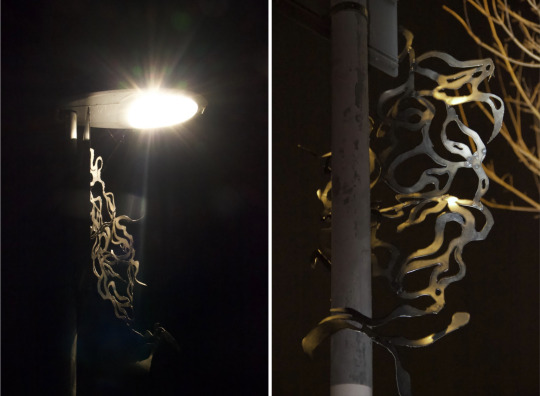
During my FMP I aim to consider more thoroughly the history and prehistory of the substances I am using. Though I’m not yet sure what form I would like to make my final piece, over the course of the project I would like to try carving into stone, to create a microcosm of human impacts on the landscape and geological epochs. As in my piece ‘Albatross’, I will also definitely be continuing my use of trash during this project - I would like to use as many found and recycled materials as possible, to ensure that I am not worsening the problems I am protesting.
0 notes
Text
I would like to expand my research practice during FMP to address the many troubling social issues connected to the climate crisis and overproduction - though the project will probably focus mainly on nonhuman objects, I don’t want to falsely isolate the exploitation of natural resources from the exploitation of human beings.
0 notes
Photo
In ‘Ephemeral Utopia’, Galhotra depicts the earth as we know it as an architectural find, metaphorically representing the fact that the landscape has been profoundly, irreversibly altered during the Anthropocene, a process that may continue into oblivion.
Galhotra’s work deals regularly with the Anthropocene and the climate crisis. From her website:
Offering a counter to the conventional approach to environmental studies, Galhotra seeks to expand the discourse to include history, theory, political intervention, economy, tradition, and culture when considering the current state of environmental degradation. Her process-oriented practice is based on both research and intuition; her work dwells between the personal and public, reality and belief, and science and spirituality to explore the shifting landscape of society.
In ‘Absence Presence’, Galhotra installed sculptures of sparrows in changing site-specific public locations. This installation represents the massive decline of species during what is now being called the world’s sixth mass extinction event. I would like to create a piece with a similar tone - subtle and potentially mistaken for lighthearted at first glance, while having a darker message.
My piece, ‘Reliquary’, also deals with bearing witness to the death of a bird. I intended it to preserve the feeling of shock that occurs when a human sees a dead animal without warning, to act as a remedy against desensitisation.
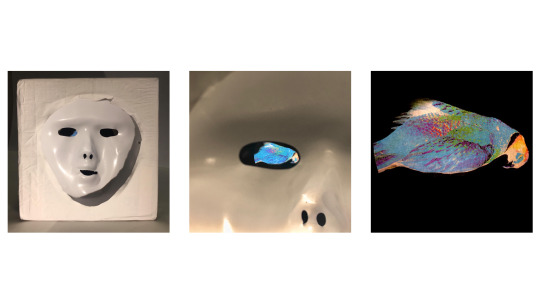
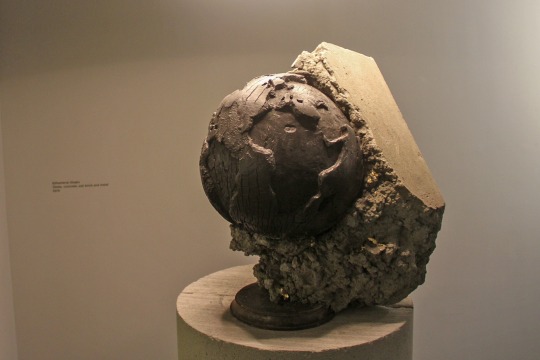
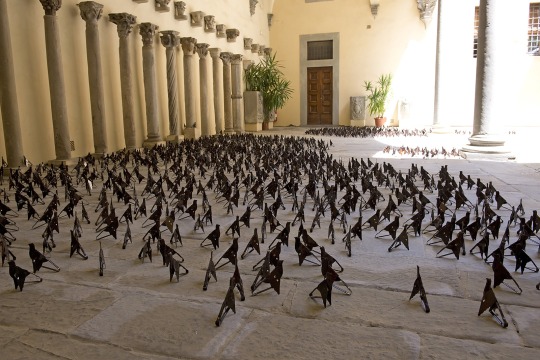
‘Ephemeral Utopia’, from ‘Climaterics’ exhibition, 2018 (left), and ‘Absence Presence’, 2011 (right), by Vibha Galhotra
2 notes
·
View notes
Photo


‘Ephemeral Utopia’, from ‘Climaterics’ exhibition, 2018 (left), and ‘Absence Presence’, 2011 (right), by Vibha Galhotra
2 notes
·
View notes
Photo
Drayson is another artist who uses a conceptual application of traditional drawing materials. She connects her subject matter - fossilised megafauna - to her material, which is listed on her website not as charcoal but as carbon. The running thread of carbon through matter - whether categorised as living, dead or ‘inanimate’, is something I wish to highlight with my work.


‘Sandie, Jackie, Lucille, Pattie, Donna, Nancy’, by Frances Drayson, 2021
3 notes
·
View notes
Text
Once the FMP begins, I am going to read Jane Bennett’s book ‘Vibrant Matter, a Political Ecology of Things’, which repositions ‘inanimate’ objects as powerful forces worthy of equal regard to sentient creatures. I will also be reading ‘In the Dust of this Planet’ by Eugene Thacker, which connects to the subject of planetary dysphoria and “suggests that we look to the genre of horror as offering a way of thinking about the unthinkable world” (Google Books).
1 note
·
View note
Photo


‘Sandie, Jackie, Lucille, Pattie, Donna, Nancy’, by Frances Drayson, 2021
3 notes
·
View notes
Photo
I recently visited this exhibition, which dealt with the disrespect of human remains by research institutions. It included large-scale graphite drawings of ancient Egyptian memorials to the dead, using this painstaking medium as a tribute of care towards the individuals being disrespected by the voyeurism of museums. Her concern for the disrespect of the dead parallels my interest in the lack of respect given to hydrocarbons. With both being seen as dead or inanimate, they are exploited as means to an end, despite having once been alive, or composed of once-living organisms.
I was inspired by her use of graphite drawing - a medium seen as ‘basic’ or ‘overly simplistic’ by many in the art world - applied in a conceptual way, particularly ‘Mastaba Scene’, the entirely blocked out graphite drawing in the top left photo, which depicts the interior of a closed Egyptian tomb.
Conceptual application of drawing is something I would like to explore during FMP; graphite and charcoal are carbon based and therefore connect to the concept of Physical Ghosts.

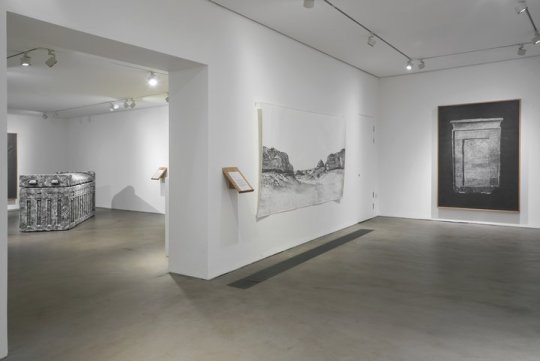
‘Out of an Instance of Expiration Comes a Perennial Showing’, exhibition by Gala Porras-Kim at Gasworks, 2022
2 notes
·
View notes
Photo


‘Out of an Instance of Expiration Comes a Perennial Showing’, exhibition by Gala Porras-Kim at Gasworks, 2022
2 notes
·
View notes
Photo
Though I do not aim to replicate Kemp’s incredibly precise and detailed technique, his work is a fascinating aesthetic and historic reference. The diatoms he uses in his assemblages are similar to those that make up crude oil. I would like to experiment further with representing these forms in my artworks, perhaps combining replicas of them sculpturally with found plastic.
!! This would also be an interesting way to play with scale - to hugely magnify microscopic objects, maybe in juxtaposition with huge geological forms shrunk onto the same scale? Maybe I could look at maps or topography (in urban areas? Or maps of the same area in prehistoric times?)
I also see Kemp’s work as making him a small ‘god’, or a Frankenstein figure, though with a far more dedicated and loving attitude than both.


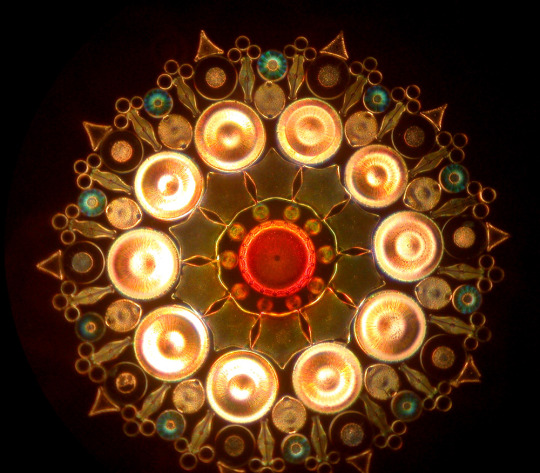

Microscopic diatom arrangements by contemporary artist and biologist Klaus Kemp
1 note
·
View note
Photo
This piece has inspired me to ask the question, “what might our distant descendants forge from our bodies?”
If life survives on earth, the fossilised remains of humanity may be subject to processes of manufacturing conceptually similar to those that we use to transform microorganism-based hydrocarbons into plastic.
Even if the process of transformation does not take place via technology, its inevitability is something we must accept - though everything about the way we live our lives endeavours to let us forget it, we are formed of borrowed matter. Our carbon must be returned to the earth: “It wants our bodies, / the landscape does, and everyone runs the risk of / being swallowed up. Can we love nature for what it / really is: predatory? We do not walk through a passive / landscape.” - [Richard Siken, Landscape with Fruit Rot and Millipede].
I am also interested in digital manipulation and 3D printing as a possible material reference.
Transcribed note from my sketchbook: “plastics, oil, synthetic material and hydrocarbon-based fuel were once organic - they are simply revenants of things that once lived. we as physical assemblages of matter - though we try to forget - will also pass into this cycle of carbon. we will presumably become a material resource for distant innovators.”


‘Data rocks’ from New Babylon by Lucy Hutchinson and Sophie Huckfield, 2019
3D printed ‘rocks’ shaped by medical datasets mined from the body
2 notes
·
View notes
Text
Please contextually reference your subject matter. What art, design, cultural, historic references can you look at to gain insight?
I have been considering the uncanny and abject aspects of trash and humanmade environments for most of this year, but reading the 2013 paper ‘Planetary Dysphoria’ by Emily Apter crystallised the concept for me. Though my focus is much smaller scale - microcosmic rather than planetary - and my opinions are less nihilistic, Apter’s perspective on existential horror is similar to what I aim to evoke.
Apter coins the term ‘planetary dysphoria’ to encapsulate the state of collective anxiety and horror that hangs over the contemporary world. As Apter puts it,
“planetary dysphoria captures the geopsychoanalytic state of the world at its most depressed and unruhig, awaiting the triumphant revenge of acid, oil and dust. These elements demonstrate a certain agency: they are sentient materials even if they are not fully licensed subjectivized subjects.”
Apter then quotes McKenzie Wark, who says,
“Our permanent legacy will not be architectural, but chemical. After the last dam bursts, after the concrete monoliths crumble into the lone and level sands, modernity will leave behind a chemical signature, in every- thing from radioactive waste to atmospheric carbon. This work will be abstract, not figurative.” [‘An Inhuman Fiction of Forces’, in ‘Leper Creativity’, 2012]
The ‘chemical signature’ is the collective haunting of what I describe as Physical Ghosts.
0 notes
Text
IT IS IMPORTANT TO MAKE IT CLEAR THAT WHAT I AM PROTESTING IS NOT PRODUCTION OR EXPLORATION, BUT EXPLOITATION. THE ENEMY IS NOT CURIOSITY, BUT HUBRIS; IT IS NOT INNOVATION, BUT COMPLACENCY.
0 notes
Text
Please introduce your chosen subject area. What interests you as potential starting points or areas of research? What influenced this choice?
I have chosen to explore the aspects of horror and the uncanny in mundane objects and urban environments. I will be examining hydrocarbon-based materials such as single-use plastics, bringing in their relationship to aspects of uncontrolled nature that slot in around the edge of cities, such as vermin, ‘roadkill’ and fungi. I want to explore the way that these objects act as sites where the veil of the anthropocene over the nonhuman world is at its thinnest, or its most absurd.
Plastic is perhaps the most commonly accepted receptor of the label ‘inanimate’. It is seen by most humans as the furthest thing possible from a living creature. It performs none of the functions necessary for life (movement, respiration, sensitivity, growth, reproduction, excretion or nutrition), and to call it ‘dead’ would seem questionable. However, it is not as far removed from live matter as we often assume. The plastics we often discard so easily have their origins in prehistory; they are formed from the bodies of microscopic diatoms, zooplankton and algae - organisms that were clearly once alive, millions of years ago. I am fascinated by the way that this indicates the existence of a cutoff point between things defined as ‘dead’ and things defined as ‘inanimate’. There is also a sick cyclicality in the way plastic directly harms living creatures today - when plastic is viewed as an amalgamation of bodies, it appears that living organisms are being killed by their own distant ancestors.
I intend to approach this project by examining the origins of the materials used to form plastics and the afterlives of these manufactured products once they have served their intended purpose. I have recently been studying and drawing the forms of the microorganisms that make up crude oil, and am planning to research more into the carbon cycle and its chemical processes. I would also like to expand my research into the prehistoric lifeforms that once inhabited the area of London, to better understand the area’s past.

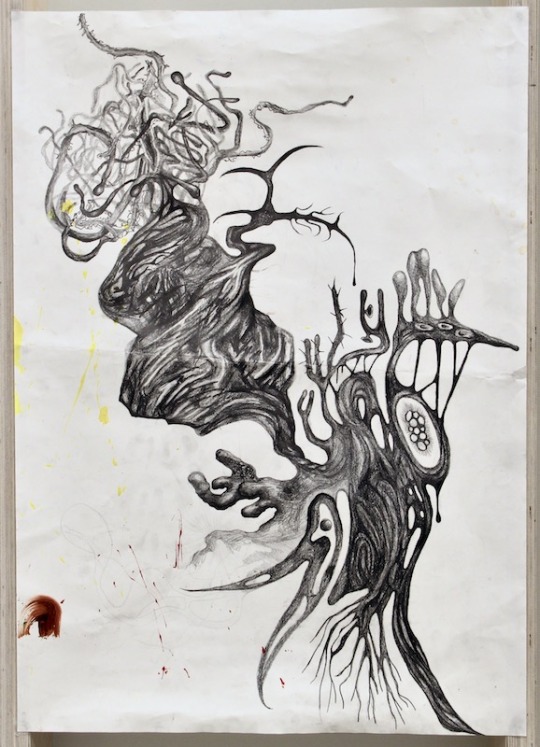
Zooplankton (above); my drawing ‘Ectoplastic’ abstracting the forms of prehistoric organisms and plastic (below)
I am fascinated by the profound effect that humanity has had on our environment. I have recently been reading about the Anthropocene, the proposed new epoch we currently reside in, defined by the impacts of human innovation on the chemical makeup of our planet and atmosphere. My interest in these subjects stems from my anxiety about climate disaster and my belief in the spiritual significance of the mundane. I have long believed that nothing is truly boring, and with my artworks I aim to expose the intricate and perhaps dark underbellies of things we take for granted. Plastics, especially small pieces of trash, are a perfect example of this - they lie innocuously in our everyday fields of vision as sites of quiet horror.
I am interested in exploring the human impact on the environment on a microcosmic scale; the ways in which the Anthropocene’s warping of physical space manifests in urban environments. I am fixated on the idea that humans’ tampering with natural cycles results in hauntings - that our manipulation of our environment through the synthesisation of substances and natural phenomena creates ‘physical ghosts’. They are given neither the status of ‘alive’ or ‘dead’, despite having very real effects on their surroundings and outlasting the humans who create and use them. They haunt our daily lives as paradoxes - both seen and not-seen, inanimate and impactful, purposeful and waste.
On a personal level, I want this project to act as a remedy against complacency. Subjects such as chaotic epochs, climate disaster and mass extinction, as well as attempting to understand the scale of prehistory, are so broad that they can become difficult to hold in your head. This difficulty can threaten to slide into either nihilism or desensitisation, both of which I am trying to escape. Sometimes something small and unsettling can have a greater emotional impact than a vast looming threat; it is easier for the human brain to digest and view in relation to itself. Therefore I currently envision the pieces I am going to make as more subtly unsettling than aiming for existential horror; however, I want to influence the audience to view ‘inanimate’ matter as worthy of respect.
0 notes
Audio
This song’s lyrics and frantic, overwhelming energy encapsulate my rage at the exploitation of natural resources by corporations and the mega-rich, as they create a killing cycle for the sake of profit.
{Verse 1}
They built a condo on your tomb
The earth is rotted to the root
A marble corpse like sister moon
They gentrified the hellscape dude!
And charged you extra for the views
Nothings too taboo
Fuck the many for the few
Getting shitfaced off of fossil fuel
Spit in the face of god we’ll never lose
{Bridge}
Shock!
Deprivation!
Shock!
Desperation
Shock!
Annihilation!
Shock!
Paid vacation!
(It's just the beginning)
(It's just the beginning)
(It's just the beginning)
(It's just the beginning)
{Chorus}
Necroculture vulture system shock collar
Necroculture vulture spineless fillet
Necroculture vulture piss on your grave
Necroculture vulture prime real estate
They demand a sacrifice
They demand a sacrifice
Of your life
{Verse 2}
Cut through the meat until you hit the bone
You’ve been bought and you will be sold
Found a vein, struck gold the oldest story ever told
Were out here killing cultures new and old
Without feeling and without a soul
That's punk rock dude thats fucking radical so it goes
{Bridge}
Shock!
Deprivation!
Shock!
Desperation
Shock!
Annihilation!
Shock!
Paid vacation!
Shock!
Eco-mutation!
Shock!
Palpations!
Shock!
Automation!
Shock!
Ethno-erasure!
{Chorus}
Necroculture vulture system shock collar
Necroculture vulture spineless fillet
Necroculture vulture piss on your grave
Necroculture vulture prime real estate
They demand a sacrifice
They demand a sacrifice
Of your life
0 notes